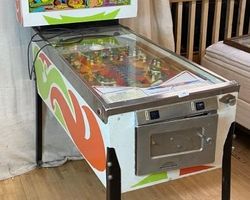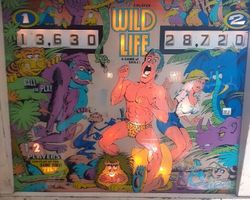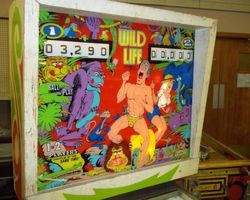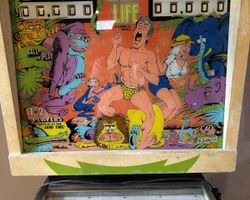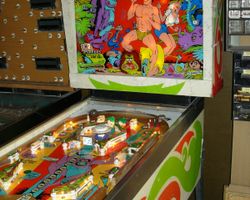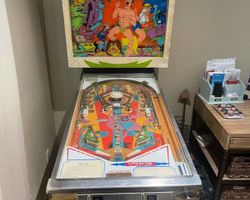Wild Life

Average Prices: USD $200 to $700
Produced: November, 1972
Production Run: 3,875 units
Machine Type: Electro-mechanical
Players: 2
Design by: Ed Krynski
Art by: Gordon Morison
"Wild Life," released by D. Gottlieb & Co. in November 1972, stands as an example of electro-mechanical (EM) pinball design from that era. This two-player machine, bearing the model number 335, was part of a trio of games sharing a common playfield layout, including the four-player "Jungle" (1972) and the single-player add-a-ball "Jungle King" (1973). A total of 3,875 units of "Wild Life" were produced, making it a moderately distributed title for its time.
The machine's creation involved key figures in Gottlieb's design team. Ed Krynski, known for his prolific work as a game designer, conceived the playfield layout and gameplay mechanics. His designs often emphasized straightforward objectives and shot consistency, a hallmark of EM games that encouraged player skill and precision. The visual identity of "Wild Life" was brought to life by Gordon Morison, Gottlieb's staff artist. Morison's artwork for "Wild Life" leaned into a vibrant jungle theme, populated by stylized animals. This thematic choice aligned with a common trend in pinball at the time, offering players an escape into exotic or adventurous settings.
Signature Features and Design
"Wild Life" distinguishes itself with specific mechanical elements and visual flair characteristic of early 1970s pinball. The most prominent feature, termed an "action ring" on Gottlieb's promotional flyer, is essentially a semi-enclosed pop bumper situated centrally on the upper playfield. This unique housing for the pop bumper creates a contained area where the ball can interact repeatedly, adding a distinct element of chaos and scoring potential.
Another notable feature is the spinning target, positioned strategically to offer a high-value shot. Striking this target not only registers points but can also keep the ball in motion, potentially leading to a series of rapid hits and score accumulation. The game also incorporates a left outlane kickback, a player-activated or timed mechanism designed to save a ball that would otherwise drain, offering a momentary reprieve and an opportunity to continue play. Complementing this is a right outlane ball return gate, which can guide the ball back into play, reducing frustrating drains.
Visually, the machine's backglass artwork, a creation of Gordon Morison, is often singled out for its colorful and engaging depiction of jungle animals in humorous situations. When lit, the backglass transforms, enhancing the game's inviting aesthetic. The cabinet artwork aligns with the era's design principles, featuring sturdy construction and graphics that extend the jungle theme from the backglass. While the backglass is widely praised, the playfield artwork, also by Morison, presents a more minimalist and somewhat cartoonish style, focusing on clear shot indicators and a less cluttered presentation compared to some of his other works. The playfield plastics, however, often feature vibrant hues that add visual appeal to the playing surface.
Playfield and Mechanics
The "Wild Life" playfield layout, designed by Ed Krynski, reflects the straightforward yet challenging philosophy of EM pinball. The lower playfield features two flippers, positioned to control the ball's trajectory and facilitate shots toward the upper half of the game. Two slingshots flank the flippers, providing reactive deflections that can send the ball quickly back into play or toward outlanes.
Ascending the playfield, players encounter a single central pop bumper, the aforementioned "action ring," which serves as a focal point for chaotic ball movement and score generation. Surrounding this area are a series of rollovers and targets. Ten star rollovers are distributed across the upper playfield, providing opportunities for players to rack up bonus points. Two standup targets offer direct scoring opportunities and can contribute to lighting specific features or advancing game objectives. The central spinning target, a key scoring element, encourages precise shots through a narrow lane.
The flow of "Wild Life" is largely centered around the upper playfield, particularly the interactions with the spinner and the enclosed pop bumper. Shots through the orbits can feed the ball into this area, creating a dynamic exchange. The design philosophy encourages players to master shots that activate the spinner, while also trying to strategically hit the rollovers and targets to build up the end-of-ball bonus. The presence of a left outlane kickback and a right outlane ball return gate adds strategic depth, as players might attempt to activate these features to extend ball time, turning potential drains into scoring opportunities. The overall aesthetic of the playfield is direct, with clear lines and objectives, allowing players to quickly grasp the shot geometry.
Gameplay Dynamics
"Wild Life" offers a gameplay experience rooted in the mechanics of its era, emphasizing shot accuracy, bonus accumulation, and strategic ball preservation. The primary objectives revolve around repeatedly hitting the spinning target for high scores and activating the star rollovers. Each rollover hit contributes to an end-of-ball bonus, which is multiplied and awarded once the ball drains, making every rollover significant throughout play. The game's scoring system rewards consistent play rather than complex multi-ball modes or multi-stage objectives.
Unique to "Wild Life" are the side special lanes. Successfully guiding the ball into these lanes can light the "SPECIAL" feature, which, when hit, awards a free game or replay. This element introduces a layer of risk-reward, as these lanes are often close to the outlanes, demanding precision to access without draining. The left outlane kickback is a particularly valuable feature; it can be activated through specific shot combinations or at random, providing a save that can turn a losing ball into a chance for a major score. Similarly, the right outlane features a ball return gate that can redirect the ball back into play, mitigating the harshness of an outlane drain.
Player strategies often focus on maximizing spins on the central target, attempting to hit it multiple times before the pop bumper or slingshots redirect the ball. Another common approach involves trying to systematically light all the star rollovers to maximize the end-of-ball bonus. Mastering the subtle nudges and flipper techniques to control the ball's movement and direct it toward desired targets is paramount. The game can be set to offer a double bonus on the last ball, further incentivizing players to make every shot count in the final moments of the game. The simplicity of its mechanics, combined with the clear objectives, allows for immediate understanding, yet provides room for skill development through practice.
Reception and Legacy
"Wild Life" elicits a range of opinions within the pinball community, reflecting its design choices and the tastes of players who appreciate different eras of pinball. Many enthusiasts commend its backglass artwork, often citing it as colorful, charming, and a standout example of Gordon Morison's talent when illuminated. The jungle theme and the whimsical animal characters are frequently mentioned as engaging. For those who appreciate electro-mechanical machines, "Wild Life" is often regarded as a representative example of Gottlieb's early 1970s output, embodying the tactile feedback and distinct sounds unique to EM games. The central spinner shot is a recurring highlight for many, offering a satisfying feedback loop as the score reels rapidly advance. Some players find the gameplay, despite its apparent simplicity, to be surprisingly addictive, providing a consistent challenge that encourages skill improvement. The strategic elements of the outlane kickback and ball return gate are also noted as positive features for an EM machine of its time.
However, "Wild Life" also faces criticism, particularly regarding its playfield artwork, which some describe as plain, amateurish, or even unattractive. This contrast with the well-received backglass is a frequent point of discussion. The gameplay itself is sometimes perceived as too simple by players accustomed to more complex modern machines or even other EMs with more varied shot geometries. The concentration of gameplay around the single pop bumper and spinner area leads some to feel that the game lacks variety and can become repetitive quickly. While the spinner shot is enjoyable for some, others find it frustrating due to the ball's tendency to be stopped by the pop bumper before extended spins can be achieved. The overall design and flow are occasionally characterized as clunky, particularly when compared to other Gottlieb titles of the same period.
Despite these mixed views, "Wild Life" holds a place in pinball history as part of a significant design lineage. Its shared playfield layout with "Jungle" and "Jungle King" makes it a curious case study in how a single design could be adapted for different player counts and rule sets. As an electro-mechanical game, it represents a period of transition in pinball technology, preceding the widespread adoption of solid-state electronics. Its continued presence in collections and at shows ensures its legacy endures as a piece of pinball's past, offering a direct, skill-focused experience that stands apart from more elaborate contemporary designs.
Sponsored Links
 Ebay Listings
Ebay Listings
 Auction Results
Auction Results
| Cost | Location | Date |
|---|---|---|
| GBP £1,384 |  Bognor Regis, United Kingdom Bognor Regis, United Kingdom |
19 February, 2025 |
| USD $400 |  Pennsylvania, United States Pennsylvania, United States |
06 May, 2024 |
| EUR €1,450 |  Saarland, Germany Saarland, Germany |
24 February, 2022 |
| USD $315 |  Indiana, United States Indiana, United States |
22 February, 2022 |
| USD $500 |  Pennsylvania, United States Pennsylvania, United States |
13 January, 2022 |
| USD $527 |  California, United States California, United States |
17 August, 2021 |
| USD $2,250 |  Pennsylvania, United States Pennsylvania, United States |
13 October, 2019 |
| USD $1,800 |  Indiana, United States Indiana, United States |
27 June, 2019 |
| AUD $1,175 |  New South Wales, Australia New South Wales, Australia |
09 March, 2019 |
| USD $500 |  Colorado, United States Colorado, United States |
13 January, 2018 |


Private Policy · Search Website · Contact Us
As an eBay Partner, we may earn a commission from qualifying purchases made through links on this site, at no additional cost to you.
All trademarks and copyrighted materials remain property of their respective owners. All other content copyright 2007 - 2025 Pinpedia.

